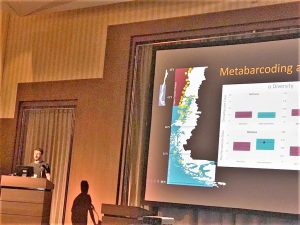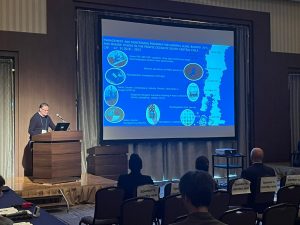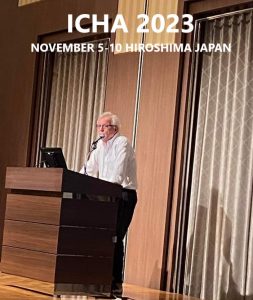In Japan, Fisheries Development Institute’s Researchers participated in (ICHA 2023) harmful algal blooms main world conference
December 6th, 2023Between November 5th and 10th, in the city of Hiroshima Japan, (ICHA 2023) Harmful Algae International Conference twentieth version was held, an event attended by 550 scientists from 70 countries. Fisheries Development Institute, through the Harmful Algae Research Center (CREAN IFOP) was present with 3 researchers, Dr. Gonzalo Fuenzalida, Dr. Oscar Espinoza and Dr. Leonardo Guzmán. Chile on this occasion was only represented by 7 researchers linked to these events, belonging to Universidad de Concepción, Universidad de Magallanes and Fisheries Development Institute.
 Dr. Fuenzalida presented a contribution developed by five co-authors, “Exploring omics technologies for effective HABs monitoring in Southern Chile”, which showed the application of metabarcoding (“metabarcoding”) and metagenomics, as tools to improve monitoring. of harmful algae in Chile. To do this, he sequenced the 18S ribosomal gene from samples collected at 34 sites distributed between 36° and 55°, from the Biobío region to the Beagle Channel in the Magallanes region and Chilean Antarctica, which made it possible to evaluate the composition and diversity of phytoplankton assemblages, with variations in richness and dominance observed between studied areas, Pacific Ocean and fjords/channels in the south of the country; The observed variability probably originates from differences between both sectors in temperature, salinity and nutrient levels. Regarding metagenomic analysis, 4,670 genes associated with responses to temperature, light intensity, nutrient assimilation, and toxin production were identified, providing background information on the key metabolic pathways that underlie the physiological and metabolic changes of the assemblages of phytoplankton. The results of this research provide very valuable information for strategies aimed at predicting and mitigating harmful algal bloom events in Chile.
Dr. Fuenzalida presented a contribution developed by five co-authors, “Exploring omics technologies for effective HABs monitoring in Southern Chile”, which showed the application of metabarcoding (“metabarcoding”) and metagenomics, as tools to improve monitoring. of harmful algae in Chile. To do this, he sequenced the 18S ribosomal gene from samples collected at 34 sites distributed between 36° and 55°, from the Biobío region to the Beagle Channel in the Magallanes region and Chilean Antarctica, which made it possible to evaluate the composition and diversity of phytoplankton assemblages, with variations in richness and dominance observed between studied areas, Pacific Ocean and fjords/channels in the south of the country; The observed variability probably originates from differences between both sectors in temperature, salinity and nutrient levels. Regarding metagenomic analysis, 4,670 genes associated with responses to temperature, light intensity, nutrient assimilation, and toxin production were identified, providing background information on the key metabolic pathways that underlie the physiological and metabolic changes of the assemblages of phytoplankton. The results of this research provide very valuable information for strategies aimed at predicting and mitigating harmful algal bloom events in Chile.
 For his part, Dr. Espinoza presented “Harmful algal blooms dynamics and toxic outbreaks in coastal waters of Central-Southern Pacific Ocean Chile (36°-44°S)” research, whose co-authors were 10 researchers, providing valuable information to support monitoring and future actions, particularly in a climatic change scenario. The study evaluated phytoplankton assemblages and harmful species occurrence in the Pacific Ocean of central southern Chile between 2016 and 2023, showing from a hydrographic point of view 3 latitudinal transition areas, Biobío (BB), La Araucanía-Los Ríos (AR) and south of the Chacao channel (LL). Various harmful blooms, different microalgae and different toxins are shown.
For his part, Dr. Espinoza presented “Harmful algal blooms dynamics and toxic outbreaks in coastal waters of Central-Southern Pacific Ocean Chile (36°-44°S)” research, whose co-authors were 10 researchers, providing valuable information to support monitoring and future actions, particularly in a climatic change scenario. The study evaluated phytoplankton assemblages and harmful species occurrence in the Pacific Ocean of central southern Chile between 2016 and 2023, showing from a hydrographic point of view 3 latitudinal transition areas, Biobío (BB), La Araucanía-Los Ríos (AR) and south of the Chacao channel (LL). Various harmful blooms, different microalgae and different toxins are shown.
During the period studied, blooms occurred with a high abundance of dinoflagellates during the fall of 2016 and the summer of 2018 with atmospheric-oceanographic conditions that favored Alexandrium catenella’s proliferation (5,000 and 375 cells mL-1, respectively) with a high concentration of paralyzing toxin in shellfish (6.6 x 103 and 1.5 x 103 μg STX eq 100g-1, respectively) in LL. Furthermore, during the summer of 2018, a Kareniaceae flowering occurred (390 cells mL-1), causing mass death of pelagic and benthic marine organisms in the sector between LL and AR. During the summer of 2019, a flowering of Dinophysis acuminata (317 cells mL-1) with production of pectenotoxins (PTX-2) (54 μg kg-1) was recorded in the BB sector. The diatom Pseudo-nitzschia cf. australis was recorded during the summer and autumn of 2022 (2,000 and 200 cells mL-1 in the LL and BB sectors, respectively), associated with the accumulation of domoic acid (DA) in shellfish (140 and 23.3 μg DA kg-1 , respectively), with extractive bans in both areas. DA is also known as shellfish amnesia toxin.
 Finally, Dr. Guzmán presented “Distribution and abundance of Alexandrium catenella in Chilean fjords”, a contribution developed by 8 co-authors. This microalgae in Chile is distributed between Coliumo (36°S) in the Biobío region and Mariotti islets (55°S) in Magallanes and Chilean Antarctica region, being more frequent and abundant in fjords and channels. The study shows that in the last 15 years, in addition to the development of permanent monitoring to detect harmful microalgae and marine toxins, research actions have been carried out that have made it possible to have a hydrodynamic model that allows us to appreciate the processes that characterize the fjord system. , and that it has been possible to incorporate particle dispersion models, which are applicable to harmful algal blooms. In this context, the effort to combine field work, laboratory experimentation and particle dispersion models to achieve a better understanding of A. catenella blooms was presented. The blooms of this microalgae that occurred in the central and northern sector of the fjords in the years 2018 and 2021 are contrasted, given that they showed different geographical coverage, but as a common feature the fact that both originated in the extreme south of the Aysén region, but the first was observed in the extreme south and southeast of Chiloé´s large island . Hydrographic and meteorological conditions and distribution and abundance of A. catenella in both blooms are contrasted, concluding that for certain blooms, the direction and intensity of the winds and the behavior of surface currents are key to understanding the distribution and abundance of this dinoflagellate. and consequently the flowering may show a wide geographical coverage (blooming in 2018) or be limited to a more restricted sector of the fjords (blooming in 2021).
Finally, Dr. Guzmán presented “Distribution and abundance of Alexandrium catenella in Chilean fjords”, a contribution developed by 8 co-authors. This microalgae in Chile is distributed between Coliumo (36°S) in the Biobío region and Mariotti islets (55°S) in Magallanes and Chilean Antarctica region, being more frequent and abundant in fjords and channels. The study shows that in the last 15 years, in addition to the development of permanent monitoring to detect harmful microalgae and marine toxins, research actions have been carried out that have made it possible to have a hydrodynamic model that allows us to appreciate the processes that characterize the fjord system. , and that it has been possible to incorporate particle dispersion models, which are applicable to harmful algal blooms. In this context, the effort to combine field work, laboratory experimentation and particle dispersion models to achieve a better understanding of A. catenella blooms was presented. The blooms of this microalgae that occurred in the central and northern sector of the fjords in the years 2018 and 2021 are contrasted, given that they showed different geographical coverage, but as a common feature the fact that both originated in the extreme south of the Aysén region, but the first was observed in the extreme south and southeast of Chiloé´s large island . Hydrographic and meteorological conditions and distribution and abundance of A. catenella in both blooms are contrasted, concluding that for certain blooms, the direction and intensity of the winds and the behavior of surface currents are key to understanding the distribution and abundance of this dinoflagellate. and consequently the flowering may show a wide geographical coverage (blooming in 2018) or be limited to a more restricted sector of the fjords (blooming in 2021).
